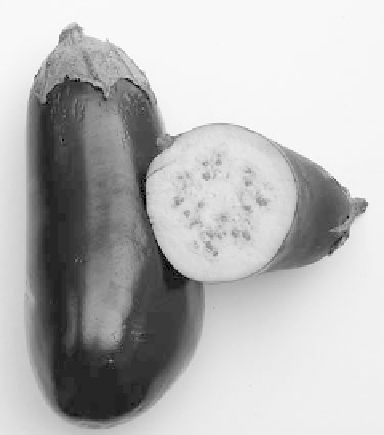Agriculture Reference
In-Depth Information
Figure
4.27.
Eggplant showing cross section with seeds visible.
(Fig. 4.27), with a white inner flesh with seeds. Peppers have a thick “skin” surrounding
a hollow space containing seeds, while tomatoes have flesh throughout with seeds.
Although one might think of peppers as being green or red (Fig. 4.28), and tomatoes
as being red, both have been bred to have many different colors from green to red,
yellow, and more different colors are being developed.
4.12.1 Climatic Adaptation
Artichoke is adapted to cool climates or at least climates with cool nights. Broccoli,
brussel sprouts, cauliflower, and tomatoes are adapted to temperate climates, although
they are also grown in tropical climates (Table 4.8). Tomatoes do not produce well
when the temperature is too high, and when the temperature is high the tomatoes pro-
duced are generally small. Eggplant and pepper are adapted to subtropical and tropical
climates, although they can also be grown in other climates.
4.12.2 Importance in Human Nutrition
As seen in Figure 4.29, of this group of vegetables, artichoke, broccoli, and brussels
sprouts are highest in calories, and artichoke and brussels sprouts are highest in carbo-
hydrates. The remaining vegetables have about the same amounts of calories and carbo-
hydrates. All have low levels of protein and fiber. Fat content varies from 0.1 to 0.4
percent for all these vegetables.









